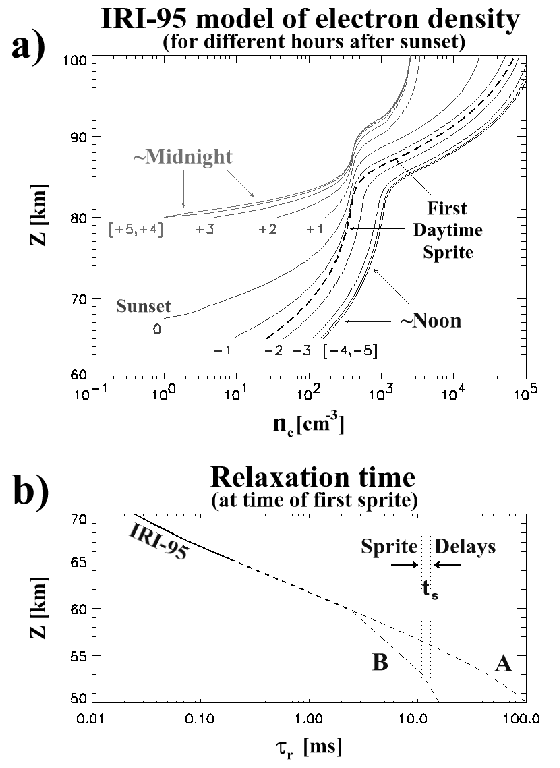The nighttime relaxation time profile was derived and shown in
Section 2.4.4. In this section, we will estimate ![]() as a function of height around the time of the daytime sprites. The
results will then be used in the next section to estimate the
initiation altitude of the sprites.
as a function of height around the time of the daytime sprites. The
results will then be used in the next section to estimate the
initiation altitude of the sprites.
Figure 4.6a shows the IRI-95 model
(Rawer et al., 1978) of electron number density (![]() ) relative to
local ground-level sunset over South Texas on August 14, 1998. The
base altitude of the model output is 65 km for daylight hours and
80 km for night. A significant change in
) relative to
local ground-level sunset over South Texas on August 14, 1998. The
base altitude of the model output is 65 km for daylight hours and
80 km for night. A significant change in ![]() occurs within
occurs within ![]() 3
hours of sunset, with the greatest change being at sunset when the
change in incident solar flux is greatest. The dashed line in
Figure 4.6a is the IRI-95
3
hours of sunset, with the greatest change being at sunset when the
change in incident solar flux is greatest. The dashed line in
Figure 4.6a is the IRI-95 ![]() profile at
23:19:48 UT, the time of the first sprite event. The solid line in
Figure 4.6b shows
profile at
23:19:48 UT, the time of the first sprite event. The solid line in
Figure 4.6b shows ![]() based on the
IRI-95
based on the
IRI-95 ![]() profile and a ``cold electron'' assumption (see
Pasko et al. (1997b)) for 65-70 km altitude at 23:19:48 UT. Note that
although
profile and a ``cold electron'' assumption (see
Pasko et al. (1997b)) for 65-70 km altitude at 23:19:48 UT. Note that
although ![]() at the time of the sprites was significantly less
than at midday, the corresponding
at the time of the sprites was significantly less
than at midday, the corresponding ![]() was still very small.
was still very small.
 |
The thick dashed line in Figure 4.6b shows the
IRI-95 ![]() extrapolated down to 60 km altitude using the
extrapolated down to 60 km altitude using the
![]() scale height at 65 km altitude. Below 60 km, ion
conductivity begins to dominate over the electron conductivity
(Reid, 1986). The thin dashed line (profile A) in
Figure 4.6b below 60 km is based upon
combining the IRI-95 electron conductivity extrapolation with the
experimentally measured ion conductivity of Holzworth et al. (1985).
The dot-dash line (profile B) in Figure 4.6b
is an interpolation between the IRI-95
scale height at 65 km altitude. Below 60 km, ion
conductivity begins to dominate over the electron conductivity
(Reid, 1986). The thin dashed line (profile A) in
Figure 4.6b below 60 km is based upon
combining the IRI-95 electron conductivity extrapolation with the
experimentally measured ion conductivity of Holzworth et al. (1985).
The dot-dash line (profile B) in Figure 4.6b
is an interpolation between the IRI-95 ![]() profile and Hale's
mid-latitude
profile and Hale's
mid-latitude ![]() profile for 53 km altitude and below
(Hale, 1994). The vertical dotted lines in
Figure 4.6b denote the range of daytime sprite
initiation time delays (
profile for 53 km altitude and below
(Hale, 1994). The vertical dotted lines in
Figure 4.6b denote the range of daytime sprite
initiation time delays (![]() : 11.0-13.2 ms) reported in this study.
Note that
: 11.0-13.2 ms) reported in this study.
Note that ![]() exceeds all
exceeds all ![]() below
below ![]() 56 km altitude
for Profile A but does so only below
56 km altitude
for Profile A but does so only below ![]() 51 km altitude for
Profile B.
51 km altitude for
Profile B.